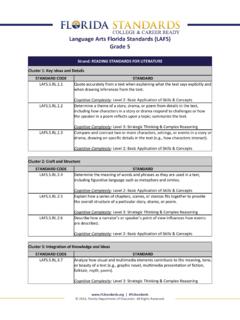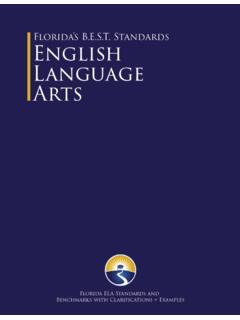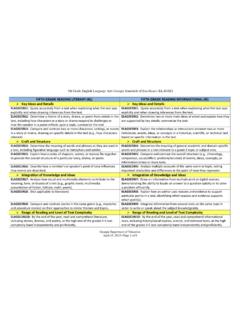Transcription of New Media Art - Introduction
1 New Media Art - Introduction - Mark Tribe - Brown 1 of 15. New Media Art - Introduction 13 Added by Anonymous, last edited by Anonymous on Feb 22, 2007. Defining New Media art Jodi, 1995. In 1993, at the start of the "dot com" boom, two European artists, Joan Heemskerk and Dirk Paesmans, paid a visit to California's Silicon Valley. When they returned home, they created , a Web site as art work whose scrambled green text and flashing images seem to deconstruct the visual language of the Web. Heemskerk and Paesmans remixed found images and HTML scripts much as Dada artists played with the photographic imagery and typography of magazines and newspapers.
2 Changed the way many people think about the Internet, demonstrating that it didn't just provide a new way to publish information; it could also be an art medium like oil painting, photography, or video. Like other works of New Media art, exploited an emerging technology for artistic purposes. 1994 was a watershed year in the linked histories of Media technology and digital culture. The Netscape Corporation introduced the first commercial Web browser, signaling the Internet's transformation from a computer network used primarily by computer enthusiasts and academic researchers into a popular medium for personal communication, publishing, and commerce.
3 Terms like "the Net," "the Web," "cyberspace," and "dot com" soon became part of the international vernacular, and a major societal shift appeared to be underway?from industrial production to information economies, from hierarchical organizations to distributed networks, from local markets to global ones. The Internet meant di erent things to di erent people: to entrepreneurs, it was a way to get rich quick; to activists, it was a means of building grassroots support for political causes; to Media magnates, it represented a new channel for distributing content. This last group used the term "new Media " to describe digital publishing forms like CD ROMs and the Web.
4 To "old Media " companies, these nascent technologies indicated a move away from traditional outlets, such as newspapers and television, to emerging forms of interactive multimedia. In 1994, major Media companies including the Hearst Corporation, which owned numerous American periodicals and television networks?formed "new Media " divisions, and trade groups such as the New York New Media Association were first organized. Around the same time, artists, curators, and critics started to use the term "New Media art" to refer to works?such as interactive multimedia installations, virtual reality environments, and Web based art?
5 That were made using digital technology. New Media art and older categorical names like "Digital art," "Computer art," "Multimedia art," and "Interactive art" are often used interchangeably, but for the purposes of this book we use the term New Media art to describe projects that make use of emerging Media technologies and are concerned with the cultural, political, and aesthetic possibilities of these tools. We locate New Media art as a subset of two broader categories: Art and Technology and Media art. Art and Technology refers to practices, such as Electronic art, Robotic art, and Genomic art, that involve technologies which are new but not necessarily Media related.
6 Media art includes Video art, Transmission art, and Experimental Film art forms that incorporate Media technologies which by the 1990s were no longer new. New Media art is thus the intersection of these two domains. We chose to limit the scope of this book to work that was New Media Art - Introduction - Mark Tribe - Brown 2 of 15. made after the term New Media art was broadly adopted in 1994, and to focus on works that are particularly influential, that exemplify an important domain of New Media art practice, and that display an exceptional degree of conceptual sophistication, technological innovation, or social relevance.
7 Deciding what counts as Media technology is a di cult task. The Internet, which is central to many New Media art projects, is itself composed of a heterogeneous and constantly changing assortment of computer hardware and software?servers, routers, personal computers, database applications, scripts, and files?all governed by arcane protocols, such as HTTP, TCP/IP, and DNS. Other technologies that play a significant role in New Media art include video and computer games, surveillance cameras, wireless phones, hand held computers, and Global Positioning System GPS devices. But New Media art is not defined by the technologies discussed here; on the contrary, by deploying these technologies for critical or experimental purposes, New Media artists redefine them as art Media .
8 In the hands of Radical Software Group RSG , for example, data surveillance software, similar to that used by the United States' Federal Bureau of Investigation FBI , becomes a tool for artistic data visualization. In addition to exploring the creative possibilities of this software, RSG develops a critique of surveillance technology and its uses. Art historical antecedents Hannah Hoch, Schnitt mit dem Kiichenmesser Dada durch die letzte Weimarer Bierbauchkulturepoche, 1920. Although New Media art is, on one level, all about the new new cultural forms, new technologies, new twists on familiar political issues it did not arise in an art historical vacuum.
9 The conceptual and aesthetic roots of New Media art extend back to the second decade of the twentieth century, when the Dada movement emerged in several European cities. Dada artists in Z rich, Berlin, Cologne, Paris, and New York were disturbed by what they perceived as the self destructive bourgeois hubris that led to the First World War, and began to experiment with radically new artistic practices and ideas, many of which resurfaced in various forms and references throughout the twentieth century. Much as Dada was in part a reaction to the industrialization of warfare and the mechanical reproduction of texts and images, New Media art can be seen as a response to the information technology revolution and the digitization of cultural forms.
10 Many Dadaist strategies reappear in New Media art, including photomontage, collage, the readymade, political action, and performance as well as Dada artists' provocative use of irony and absurdity to jar complacent audiences. Fragmented juxtapositions of borrowed images and texts in works like Shu Lea Cheang's Brandon and Diane Ludin's Genetic Response System 2001 are reminiscent of the collages of Raoul Hausmann, Hannah H ch, and Francis Picabia. Marcel Duchamp's readymades prefigured countless New Media art works involving blank appropriation, from Alexei Shulgin's WWWArt Award to RSG's Prepared PlayStation 2005 . The work of George Grosz, John Heartfield, and other Berlin Dadaists who blurred the boundaries between art and political action serve as important precedents for activist New Media art projects like Electronic Disturbance Theater's FloodNet and Fran Illich's Borderhack.










